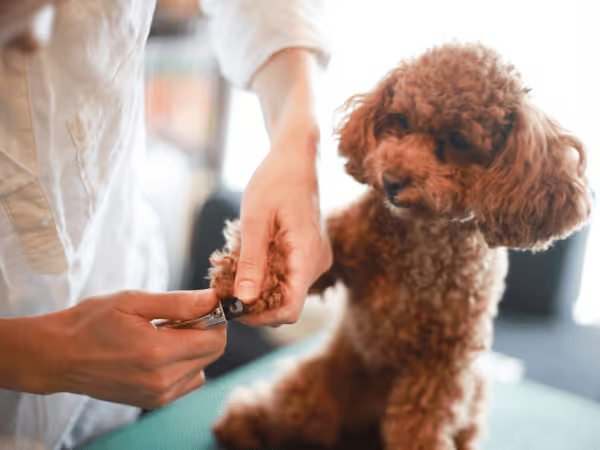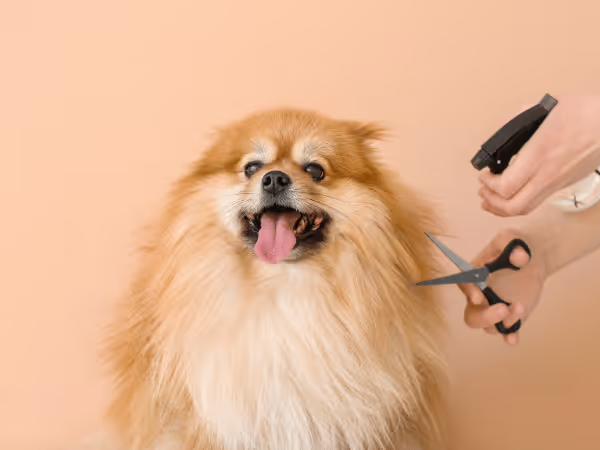This article was contributed by Pampered Paws, a top-rated pet spa and boutique in Denver, providing grooming services for dogs and cats.
I. Grooming Basics for All Dogs, Including Shorthaired Dogs
All dogs benefit from regular care, especially when it comes to their nails, ears, and in some cases, glands. These are the areas that often get overlooked at home, either because they seem minor or because most people simply aren’t comfortable with them.
1. Nails
If nails get too long, they can cause pain, posture issues, or even injury. Most pets aren’t fans of nail trims for dogs, and most owners don’t love doing them, understandably. But they still need to be done regularly.
2. Ears
Even if they look clean, ears can collect wax and debris that can lead to infections. Routine checkups and ear cleanings (with a vet-approved dog ear cleaner) help catch problems early, especially for pets prone to buildup.
3. Glands.
Some pets require assistance in expressing their anal glands. It’s not something most people want to do themselves, and that’s completely fair. If your pet is scooting or licking excessively, this could be the reason.
→ Learn more - Routine Dog Care for Health & Well-Being [Vet-Approved Checklist]
II. Dog Grooming Pointers for Curly Coated Dogs
Curly coats trap dirt, debris, and moisture more easily than straight fur, making them prone to matting and skin issues. These dogs need extra grooming, regular brushing, and occasional trims to keep their curls healthy, clean, and comfortable.
1. Preventing Curly Coat Matting
Matting, which is very common for dogs with curly hair, isn’t just a grooming issue; it's a health issue. Tangles turn into tight mats that pull on the skin, trap moisture, and create an ideal environment for irritation, itching, hot spots, and skin infections in dogs.
And once a curly coat gets matted, brushing won’t fix it. The only option is usually a full shave down. The best way to avoid that? Stick to a regular grooming schedule every 4 to 6 weeks.
2. Handling Shedding in Curly Coats
Curly-coated dogs don’t shed the way other breeds do. Old hair gets caught in their curls, and without consistent brushing and bathing, it builds up fast. Even if the coat looks okay on the outside, matting can start deep near the skin, where most pet parents won’t see it until it’s a problem.
This is another reason why sticking to a consistent brushing and grooming schedule is recommended, especially for curly-coated dogs.
3. Routine Grooming for Curly-Coated Dogs
Routine grooming keeps the coat clean, detangled, and healthy. At-home grooming is just as important as professional grooming. By visiting your groomer on a consistent schedule, it gives them a chance to check your dog’s skin, ears, and nails.
Note: Waiting too long between appointments might make grooming more challenging and can potentially cause more discomfort for your dog.

III. Dog Grooming Pointers for Double-Coated Dogs
Double-coated dogs have a dense undercoat beneath a protective outer layer, which can trap heat, dirt, and loose fur. To keep your pup comfortable, they need consistent care and thoughtful grooming treatments.
1. Why Shaving Doesn’t Help Double-Coated Dogs
When summer rolls around, it’s tempting to give your long-haired, double-coated dog a fresh shave to beat the heat. But shaving a double coat can actually do more harm than good.
However, double coats are designed by nature to regulate your dog’s temperature year-round. The thick undercoat traps warmth in winter and insulates against heat in summer. Shaving removes this natural protection, leaving your dog vulnerable to sunburn, overheating, and skin irritation.
2. De-Shedding Treatments for Double-Coated Dogs
Regular de-shedding treatments, especially in the warmer months, help keep your dog comfortable and cool. De-shedding removes loose undercoat fur safely without damaging the protective topcoat. It helps reduce shedding around the house, prevents painful mats, and keeps your dog cooler by letting their coat do its job properly.
Final Thoughts on Dog Grooming
As a final reminder, your dog’s skin and coat health is a part of their overall health. Proper nutrition, treating any canine allergies, and consistent grooming work hand in hand to help your dog look and feel their best.
Unsure how to establish a grooming schedule for your dog and want professional help to keep their coat in top shape? Pampered Paws and Sploot Veterinary Care can help! If you have any questions or concerns, please don't hesitate to reach out.






